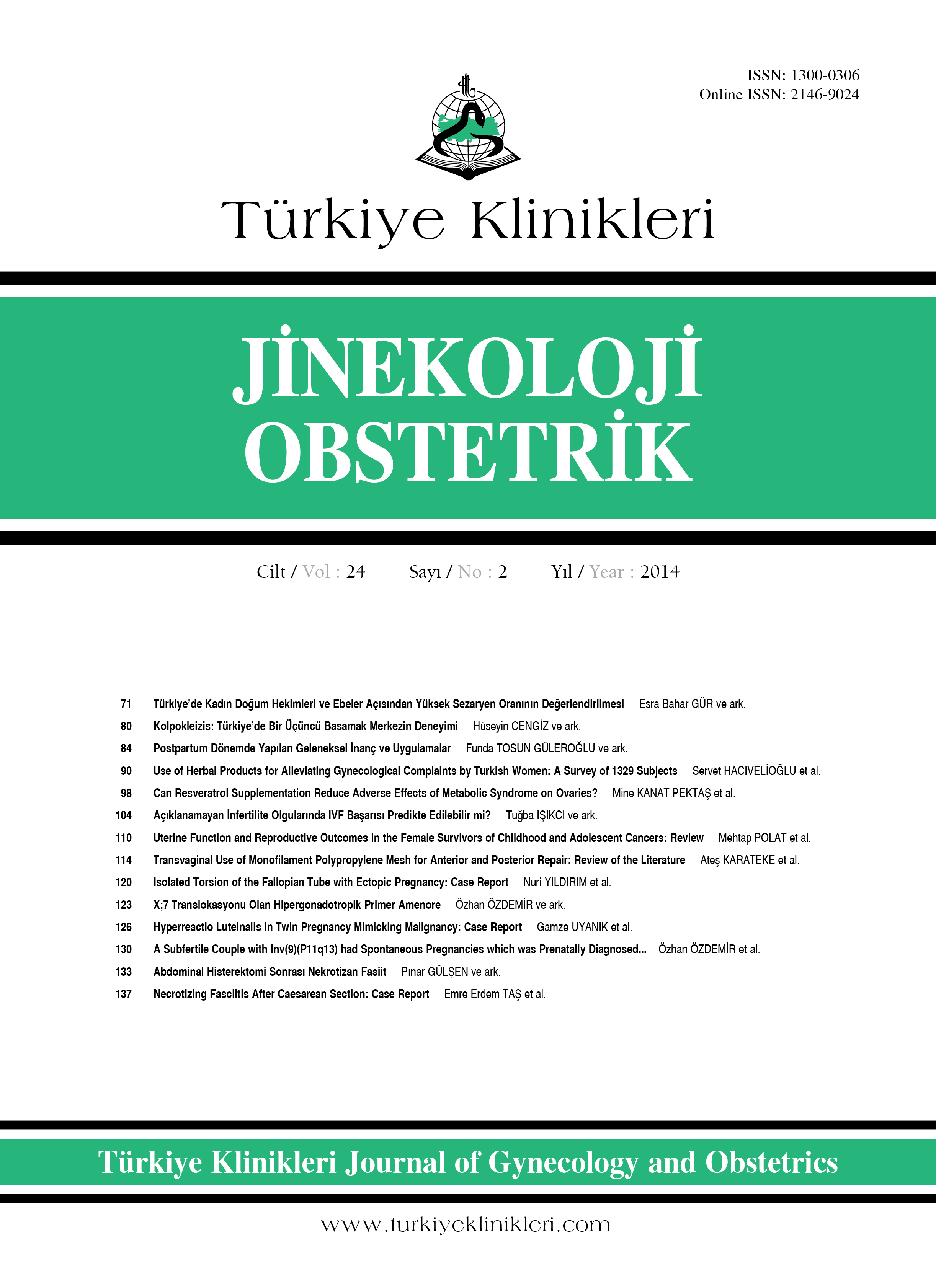Open Access
Peer Reviewed
CASE REPORTS
3697 Viewed1266 Downloaded
X;7 Translocation in Woman with Hypergonadotropic Primer Amenorrhea: Case Report
X;7 Translokasyonu Olan Hipergonadotropik Primer Amenore
Turkiye Klinikleri J Gynecol Obst. 2014;24(2):123-5
Article Language: TR
Copyright Ⓒ 2025 by Türkiye Klinikleri. This is an open access article under the CC BY-NC-ND license (http://creativecommons.org/licenses/by-nc-nd/4.0/)
ÖZET
X kromozomu ile otozomal kromozomlar arasındaki translokasyonlar oldukça nadir görülmekte olup, X-otozomal translokasyonu olan kadınlarda klinik sonuçlar oldukça heterojen bir dağılım göstermektedir. X kromozomundaki translokasyona uğrayan gen bölgesinin konumu hastanın fenotipik sonucunu belirlemektedir ve sıklıkla primer veya sekonder ovaryan yetmezlik ile ilişkilidir. X kromozomu üzerindeki kritik bölge olan Xq13-q26 bölgesini içeren translokayonlarda Turner sendromuna benzer fenotipik özellikler de eşlik etmektedir. On altı yaşında primer amenore şikâyeti ile kliniğimize başvuran olgumuzda, hipoplastik uterus ve streak overler tespit edildi. Hormonal profili hipergonadotropik hipogonadizm ile uyumlu olan hastanın yapılan karyotip analizinde ise 46,X,t(X;7)(q22p22) translokasyonu tespit edildi. X-otozomal translokasyonu ovaryan difonksiyona neden olarak hipogonadotropik amenoreye neden olabilmektedir.
X kromozomu ile otozomal kromozomlar arasındaki translokasyonlar oldukça nadir görülmekte olup, X-otozomal translokasyonu olan kadınlarda klinik sonuçlar oldukça heterojen bir dağılım göstermektedir. X kromozomundaki translokasyona uğrayan gen bölgesinin konumu hastanın fenotipik sonucunu belirlemektedir ve sıklıkla primer veya sekonder ovaryan yetmezlik ile ilişkilidir. X kromozomu üzerindeki kritik bölge olan Xq13-q26 bölgesini içeren translokayonlarda Turner sendromuna benzer fenotipik özellikler de eşlik etmektedir. On altı yaşında primer amenore şikâyeti ile kliniğimize başvuran olgumuzda, hipoplastik uterus ve streak overler tespit edildi. Hormonal profili hipergonadotropik hipogonadizm ile uyumlu olan hastanın yapılan karyotip analizinde ise 46,X,t(X;7)(q22p22) translokasyonu tespit edildi. X-otozomal translokasyonu ovaryan difonksiyona neden olarak hipogonadotropik amenoreye neden olabilmektedir.
ABSTRACT
Translocations involving X chromosome and an autosome are rather rare. Females with X-autosome translocations are a clinically heterogeneous group of patients in which X breakpoint position may influence phenotypic outcome. X-autosome translocations are frequently associated with primary or secondary ovarian failure and at times Turner syndrome-like features if there is an involvement of the critical region of Xq13-q26. A 16-year-old with a primer amenorrhea was found to have hypoplastic uterus and streak ovaries. Hormonal profile revealed hypergonadotropic hypogonadism. Chromosomal analysis revealed the karyotype to be 46,X,t(X;7)(q22;p22) de novo. The occurrence of t(X;7) in the proposita with hypergonadotropic amenorrhea confirms the role of X-autosome translocations in ovarian dysfunction.
Translocations involving X chromosome and an autosome are rather rare. Females with X-autosome translocations are a clinically heterogeneous group of patients in which X breakpoint position may influence phenotypic outcome. X-autosome translocations are frequently associated with primary or secondary ovarian failure and at times Turner syndrome-like features if there is an involvement of the critical region of Xq13-q26. A 16-year-old with a primer amenorrhea was found to have hypoplastic uterus and streak ovaries. Hormonal profile revealed hypergonadotropic hypogonadism. Chromosomal analysis revealed the karyotype to be 46,X,t(X;7)(q22;p22) de novo. The occurrence of t(X;7) in the proposita with hypergonadotropic amenorrhea confirms the role of X-autosome translocations in ovarian dysfunction.
MENU
POPULAR ARTICLES
MOST DOWNLOADED ARTICLES





This journal is licensed under a Creative Commons Attribution-NonCommercial-NoDerivatives 4.0 International License.










